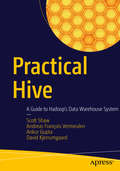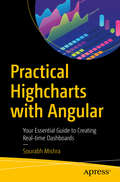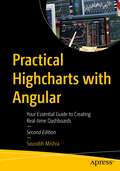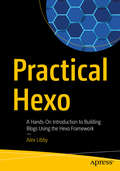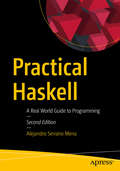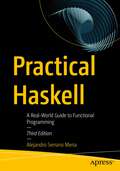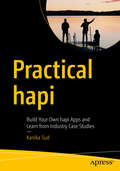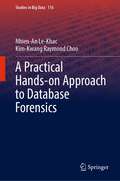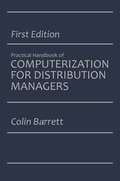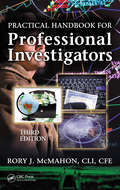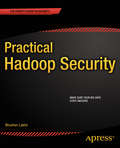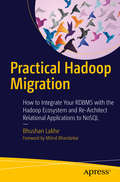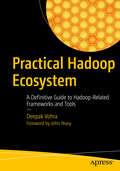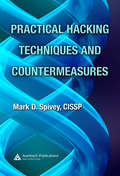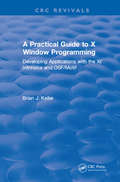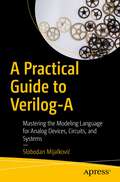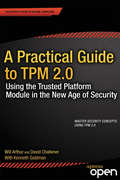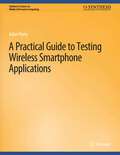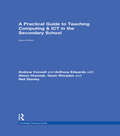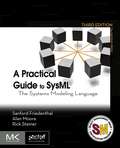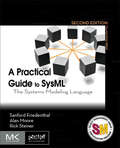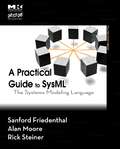- Table View
- List View
Practical Hive: A Guide to Hadoop's Data Warehouse System
by Scott Shaw Andreas François Vermeulen Ankur Gupta David KjerrumgaardDive into the world of SQL on Hadoop and get the most out of your Hive data warehouses. This book is your go-to resource for using Hive: authors Scott Shaw, Ankur Gupta, David Kjerrumgaard, and Andreas Francois Vermeulen take you through learning HiveQL, the SQL-like language specific to Hive, to analyze, export, and massage the data stored across your Hadoop environment. From deploying Hive on your hardware or virtual machine and setting up its initial configuration to learning how Hive interacts with Hadoop, MapReduce, Tez and other big data technologies, Practical Hive gives you a detailed treatment of the software.In addition, this book discusses the value of open source software, Hive performance tuning, and how to leverage semi-structured and unstructured data. What You Will LearnInstall and configure Hive for new and existing datasetsPerform DDL operationsExecute efficient DML operationsUse tables, partitions, buckets, and user-defined functionsDiscover performance tuning tips and Hive best practicesWho This Book Is ForDevelopers, companies, and professionals who deal with large amounts of data and could use software that can efficiently manage large volumes of input. It is assumed that readers have the ability to work with SQL.
Practical Highcharts with Angular: Your Essential Guide to Creating Real-time Dashboards
by Sourabh MishraHighcharts is a popular charting product that provides stunning animated and interactive charts. This concise book examines data analysis and construct the right graph. Nowadays, charting is used by the finance, education, entertainment, sports and real estate sectors to analyse their data. Built on top of of modern Javascript frameworks like jQuery and Angular, Highcharts enables developers to easily construct charts that will work in all modern browsers with pure knowledge of HTML, CSS, and JavaScript. You'll see how to use Highcharts, call backend services for data, and easily construct real-time data dashboards. You'll also learn how you can club your code with jQuery and Angular. This book provides the best solutions for real-time challenges and covers a wide range of charts including line, area, maps, plot, different types of pie chart, Gauge, heat map, Histogram chart, stacked bar, scatter plot and 3D Charts. After reading this book, you'll be able to export your charts in different formats for project-based learning. What You'll Learn Basics of Angular, consuming service through angular and implement highcharts using Angular. Use and export different chart types Work on a real-time data project calling Web API and Ajax calls through the various data sources using Angular.Create interactive styling themes and colors for a dashboard Who This Book Is For Developers, tech leads, architects or students with basic knowledge of HTML, CSS, and JavaScript who want to develop high performing, stunning, smooth, and interactive animated charts for your web products.
Practical Highcharts with Angular: Your Essential Guide to Creating Real-time Dashboards
by Sourabh MishraLearn to create stunning animated and interactive charts using Highcharts and Angular. This updated edition will build on your existing knowledge of HTML, CSS, and JavaScript to develop impressive dashboards that will work in all modern browsers.You will learn how to use Highcharts, call backend services for data, and easily construct real-time data dashboards so you can club your code with jQuery and Angular. This book provides the best solutions for real-time challenges and covers a wide range of charts including line, area, maps, plot, and much more. You will also learn about arc diagrams, bubble series, dependency wheels, and error bar series. After reading this book, you'll be able to export your charts in different formats for project-based learning. Highcharts is one the most useful products worldwide for developing charting on the web, and Angular is well known for speed. Using Highcharts with Angular developers can build fast, interactive dashboards. Get up to speed using this book today. What You’ll LearnCreate interactive animated styling themes and colors for a dashboardWork on a real-time data project using Web API and Ajax calls through different data sourcesExport charts in various formats Who This Book Is For Developers, dev leads, software architects, students or enthusiasts who are already familiar with HTML, CSS, and JavaScript.
Practical Hexo: A Hands-On Introduction to Building Blogs Using the Hexo Framework
by Alex LibbyLeverage the power of Hexo to quickly produce static blog sites that are efficient and fast. This project-oriented book simplifies the process of setting up Hexo and manipulating content, using little more than a text editor and free software. It will equip you with a starting toolset that you can use to develop future projects, incorporate into your existing workflow and allow you to take your websites to the next level. Hexo is based on JavaScript and Node.js, two of the biggest tools available for developers: you can enhance, extend, and configure Hexo as requirements dictate. With Hexo the art of possible is only limited by the extent of your imagination and the power of JavaScript and Node.js.Practical Hexo gets you quickly acquainted with creating and manipulating blogs using a static site generator approach. You will understand how to use the Hexo framework to rapidly create and deploy blogs that are performant, with the minimum of fuss, then extend and customize your content using plugins and themes. You will work through some practical projects to help solidify your skills, and put them into practice. What You'll LearnImplement the Hexo framework in a projectCustomize and extend contentConsider maintenance requirements and how they compare to other blog systemsApply skills to practical, real-world projectsCreate themes and build pluginsMake changes using other tools and libraries. Who This Book Is For Website developers who are already familiar with JavaScript and keen to learn how to leverage the Hexo framework. Agile development team members, where time is of the essence to deliver results quickly. Developers who want to focus on simplicity, to produce efficient and properly optimized content in modern browsers using tools already in their possession.
Practical HDR (2nd Edition): The Complete Guide to Creating High Dynamic Range Images with your Digital SLR
by David NightingaleThe first edition of David Nightingale's Practical HDR swiftly established itself as the standard work on this cutting-edge processing technique, garnering rave reviews and reprinting several times. Now, technical advances in the field have expanded HDR's possibilities still further, and this second, expanded edition, revised throughout, will cement David's reputation as the most respected writer in the field.Covering new programs, in particular Adobe CS5's HDR capabilities, and with more killer photos from the world's leading lights in HDR processing, Practical HDR will let the reader create jaw-dropping images that demand a second look.
Practical Haskell: A Real World Guide to Programming
by Alejandro Serrano MenaGet a practical, hands-on introduction to the Haskell language, its libraries and environment, and to the functional programming paradigm that is fast growing in importance in the software industry. This book contains excellent coverage of the Haskell ecosystem and supporting tools, include Cabal and Stack for managing projects, HUnit and QuickCheck for software testing, the Spock framework for developing web applications, Persistent and Esqueleto for database access, and parallel and distributed programming libraries.You’ll see how functional programming is gathering momentum, allowing you to express yourself in a more concise way, reducing boilerplate, and increasing the safety of your code. Haskell is an elegant and noise-free pure functional language with a long history, having a huge number of library contributors and an active community. This makes Haskell the best tool for both learning and applying functional programming, and Practical Haskell takes advantage of this to show off the language and what it can do.What You Will LearnGet started programming with HaskellExamine the different parts of the languageGain an overview of the most important libraries and tools in the Haskell ecosystemApply functional patterns in real-world scenariosUnderstand monads and monad transformersProficiently use laziness and resource managementWho This Book Is ForExperienced programmers who may be new to the Haskell programming language. However, some prior exposure to Haskell is recommended.
Practical Haskell: A Real-World Guide to Functional Programming
by Alejandro Serrano MenaGet a practical, hands-on introduction to the Haskell language, its libraries and environment, and to the functional programming paradigm that is fast growing in importance in the software industry. This updated edition includes more modern treatment of Haskell's web framework and APIs.This book contains excellent coverage of the Haskell ecosystem and supporting tools, including Cabal and Stack for managing projects, HUnit and QuickCheck for software testing, WAI and Elm to develop the back end and front end of web applications, Persistent and Esqueleto for database access, and parallel and distributed programming libraries.You’ll see how functional programming is gathering momentum, allowing you to express yourself in a more concise way, reducing boilerplate, and increasing the safety of your code. Haskell is an elegant and noise-free pure functional language with a long history, having a huge number of library contributors and an active community. This makes Haskell the best tool for both learning and applying functional programming, and Practical Haskell, Third Edition takes advantage of this to show off the language and what it can do. Free source code available on the Apress GitHub page for this book.What You Will LearnGet started programming with HaskellExamine the different parts of the languageGain an overview of the most important libraries and tools in the Haskell ecosystemApply functional patterns in real-world scenariosUnderstand monads and monad transformersProficiently use laziness and resource managementWho This Book Is ForExperienced programmers who may be new to the Haskell programming language. However, some prior exposure to Haskell is recommended.
Practical hapi: Build Your Own hapi Apps and Learn from Industry Case Studies
by Kanika SudUnderstand the core concepts of hapi and learn to build RESTful APIs that are quick, useful, and productive. Created by the mobile team at Walmart Labs, hapi is a light Node.js framework that is perfect for building API servers, websites, and HTTP proxy applications. With this quick guide, you'll learn the basics of hapi and use those skills to build an application and a REST API with MySQL. You'll then wrap up with a Capstone project of industry relevance, understanding solution design, and how hapi fits into industry relevant projects for data driven apps. Used by companies such as PayPal and Mozilla, hapi is a key framework for anyone serious about enterprise web development. Practical hapi will ensure you focus your time on critical project tasks instead of building infrastructure. What You'll Learn Utilize the power of RESTful APIs and Node.jsBuild your first hapi application based on its core conceptsWork with promises and asynchronous programming effectively Use Sequelize for database connectivityWho This Book Is For Anyone with basic knowledge of JavaScript or Node.js who wants to learn to work with hapi. A primer for the relevant Node.js and JavaScript is provided so those with general programming experience can also use this book.
A Practical Hands-on Approach to Database Forensics (Studies in Big Data #116)
by Nhien-An Le-Khac Kim-Kwang Raymond ChooAdopting an experimental learning approach, this book describes a practical forensic process to acquire and analyze databases from a given device and/or application. Databases hold important, sensitive, and/or confidential information and are a crucial source of evidence in any digital investigation. This also reinforces the importance of keeping up to date on the cyber-threat landscape as well as any associated database forensic challenges and approaches. The book also guides cyber-forensic researchers, educators, and practitioners through the process of conducting database forensics and investigations on mobile devices, Internet of Things (IoT) devices, web browsers, and end-to-end encrypted instant messaging applications. Given the fast-changing database forensics landscape, this book will be of interest to researchers, educators, and practitioners in the field, as well as students who want to learn about the database investigation.
The Practical Handbook of Computerization for Distribution Managers
by Colin BarrettBack in 1983 I was chatting with Dick Coleman, publisher of Traffic World magazine, when he unexpectedly proposed that I write a column for the magazine on computer applications in the transportation/physical distribution industry. "But, Dick, I don't know all that much about computers," I protested. "You use one, don't you?" he asked logically. Yes, I did; I'd been running my consulting business with it for two years. But that didn't, I explained, make me an expert. "Think about it," he said. That's typical Coleman; he drops these studiedly casual ideas and just lets them lay there until you pick them up and wind up doing just what he wanted you to do all along. Sure enough, the longer I pondered the notion the more it appealed to me. OK, I wasn't a computer expert (I'm still not). But I was a computer user, in the transportation/distribution field; maybe from that perspective I might have some useful things to say to other transportation/distribution users and would-be users of computers. Thus was born the "Computer Software for Transportation" column. The first one appeared in the April 11, 1983, issue of Traffic World, and it's been a once-a-month schedule ever since. And thus, too, was ultimately born this book.
Practical Handbook for Professional Investigators
by Rory J. McMahon CLI CFE Randy DicksonAn increase in fraud cases has escalated government accountability and corporate oversight, and media attention on cases ranging from missing persons to white-collar crime has increased the visibility of professional investigators. This has resulted in a great source of increased work for the profession. The third edition of Practical Handbook for
Practical Hadoop Security
by Bhushan LakhePractical Hadoop Security is an excellent resource for administrators planning a production Hadoop deployment who want to secure their Hadoop clusters. A detailed guide to the security options and configuration within Hadoop itself, author Bhushan Lakhe takes you through a comprehensive study of how to implement defined security within a Hadoop cluster in a hands-on way. You will start with a detailed overview of all the security options available for Hadoop, including popular extensions like Kerberos and OpenSSH, and then delve into a hands-on implementation of user security (with illustrated code samples) with both in-the-box features and with security extensions implemented by leading vendors. No security system is complete without a monitoring and tracing facility, so Practical Hadoop Security next steps you through audit logging and monitoring technologies for Hadoop, as well as ready to use implementation and configuration examples--again with illustrated code samples. The book concludes with the most important aspect of Hadoop security – encryption. Both types of encryptions, for data in transit and data at rest, are discussed at length with leading open source projects that integrate directly with Hadoop at no licensing cost. Practical Hadoop Security: Explains importance of security, auditing and encryption within a Hadoop installation Describes how the leading players have incorporated these features within their Hadoop distributions and provided extensions Demonstrates how to set up and use these features to your benefit and make your Hadoop installation secure without impacting performance or ease of use
Practical Hadoop Migration: How to Integrate Your RDBMS with the Hadoop Ecosystem and Re-Architect Relational Applications to NoSQL
by Bhushan LakheRe-architect relational applications to NoSQL, integrate relational database management systems with the Hadoop ecosystem, and transform and migrate relational data to and from Hadoop components. This book covers the best-practice design approaches to re-architecting your relational applications and transforming your relational data to optimize concurrency, security, denormalization, and performance. Winner of IBM’s 2012 Gerstner Award for his implementation of big data and data warehouse initiatives and author of Practical Hadoop Security, author Bhushan Lakhe walks you through the entire transition process. First, he lays out the criteria for deciding what blend of re-architecting, migration, and integration between RDBMS and HDFS best meets your transition objectives. Then he demonstrates how to design your transition model. Lakhe proceeds to cover the selection criteria for ETL tools, the implementation steps for migration with SQOOP- and Flume-based data transfers, and transition optimization techniques for tuning partitions, scheduling aggregations, and redesigning ETL. Finally, he assesses the pros and cons of data lakes and Lambda architecture as integrative solutions and illustrates their implementation with real-world case studies. Hadoop/NoSQL solutions do not offer by default certain relational technology features such as role-based access control, locking for concurrent updates, and various tools for measuring and enhancing performance. Practical Hadoop Migration shows how to use open-source tools to emulate such relational functionalities in Hadoop ecosystem components.What You'll LearnDecide whether you should migrate your relational applications to big data technologies or integrate themTransition your relational applications to Hadoop/NoSQL platforms in terms of logical design and physical implementationDiscover RDBMS-to-HDFS integration, data transformation, and optimization techniquesConsider when to use Lambda architecture and data lake solutions Select and implement Hadoop-based components and applications to speed transition, optimize integrated performance, and emulate relational functionalitiesWho This Book Is ForDatabase developers, database administrators, enterprise architects, Hadoop/NoSQL developers, and IT leaders. Its secondary readership is project and program managers and advanced students of database and management information systems.
Practical Hadoop Ecosystem: A Definitive Guide to Hadoop-Related Frameworks and Tools
by Deepak VohraLearn how to use the Apache Hadoop projects, including MapReduce, HDFS, Apache Hive, Apache HBase, Apache Kafka, Apache Mahout, and Apache Solr. From setting up the environment to running sample applications each chapter in this book is a practical tutorial on using an Apache Hadoop ecosystem project.While several books on Apache Hadoop are available, most are based on the main projects, MapReduce and HDFS, and none discusses the other Apache Hadoop ecosystem projects and how they all work together as a cohesive big data development platform.What You Will Learn:Set up the environment in Linux for Hadoop projects using Cloudera Hadoop Distribution CDH 5Run a MapReduce jobStore data with Apache Hive, and Apache HBaseIndex data in HDFS with Apache SolrDevelop a Kafka messaging systemStream Logs to HDFS with Apache FlumeTransfer data from MySQL database to Hive, HDFS, and HBase with SqoopCreate a Hive table over Apache SolrDevelop a Mahout User Recommender SystemWho This Book Is For:Apache Hadoop developers. Pre-requisite knowledge of Linux and some knowledge of Hadoop is required.
Practical Hacking Techniques and Countermeasures
by Mark D. SpiveyExamining computer security from the hacker's perspective, Practical Hacking Techniques and Countermeasures employs virtual computers to illustrate how an attack is executed, including the script, compilation, and results. It provides detailed screen shots in each lab for the reader to follow along in a step-by-step process in order to duplicate an
A Practical Guide To X Window Programming: Developing Applications with the XT Intrinsics and OSF/Motif
by Brian J. KellerA Practical Guide to X Window Programming is a basic guide that takes readers step by step through developing applications using X-Windows. The book covers the Xt Intrinsics portion of the X-Window system in detail and discusses the MIT Athena and OSF/Motif Widget Sets that are used in many of the examples. Topics covered include C programming fundamentals, text handling using X, fonts, event handling in Xt, extending the Widget Sets (building on Field Editor Widget), designing and constructing an application, building menus, printing help, OSF/Motif (including the window arranger) and interclient communication. Three extensive appendices are included: Widgets, Classing, and Exported Functions; Quick Xt Reference Guide (X11R4); and Quick Guide to OSF/Motif Widgets. Any applications designer interested in developing applications with Xt will find this book a valuable and enlightening resource.
A Practical Guide To X Window Programming: Developing Applications with the XT Intrinsics and OSF/Motif
by Brian J. KellerA Practical Guide to X Window Programming is a basic guide that takes readers step by step through developing applications using X-Windows. The book covers the Xt Intrinsics portion of the X-Window system in detail and discusses the MIT Athena and OSF/Motif Widget Sets that are used in many of the examples. Topics covered include C programming fundamentals, text handling using X, fonts, event handling in Xt, extending the Widget Sets (building on Field Editor Widget), designing and constructing an application, building menus, printing help, OSF/Motif (including the window arranger) and interclient communication. Three extensive appendices are included: Widgets, Classing, and Exported Functions; Quick Xt Reference Guide (X11R4); and Quick Guide to OSF/Motif Widgets. Any applications designer interested in developing applications with Xt will find this book a valuable and enlightening resource.
A Practical Guide to Verilog-A: Mastering the Modeling Language for Analog Devices, Circuits, and Systems
by Slobodan MijalkovićDiscover how Verilog-A is particularly designed to describe behavior and connectivity of circuits and system components for analog SPICE-class simulators, or for continuous time (SPICE-based) kernels in Verilog-AMS simulators. With continuous updates since it’s release 30 years ago, this practical guide provides a comprehensive foundation and understanding to the modeling language in its most recent standard formulation. With the introduction of language extensions to support compact device modeling, the Verilog-A has become today de facto standard language in the electronics industry for coding compact models of active and passive semiconductor devices. You'll gain an in depth look at how analog circuit simulators work, solving system equations, modeling of components from other physical domains, and modeling the same physical circuits and systems at various levels of detail and at different levels of abstraction.All industry standard compact models released by Si2 Compact Model Coalition (CMC) as well as compact models of emerging nano-electronics devices released by New Era Electronic Devices and Systems (NEEDS) initiative are coded in Verilog-A. This book prepares you for the current trends in the neuromorphic computing, hardware customization for artificial intelligence applications as well as circuit design for internet of things (IOT) will only increase the need for analog simulation modeling and make Verilog-A even more important as a multi-domain component-oriented modeling language.Let A Practical Guide to Verilog-A be the initial step in learning the extended mixed-signal Verilog-AMS hardware description language.What You'll LearnReview the hardware description and modeling language Verilog-A in its most recent standard formulation.Code new compact models of active and passive semiconductor devices as well as new models for emerging circuit components from different physical disciplines.Extend the application of SPICE-like circuit simulators to non-electronics field (neuromorphic, thermal, mechanical, etc systems).Apply the initial steps towards the extended mixed-signal Verilog-AMS hardware description language.Who This Book Is ForElectronic circuit designers and SPICE simulation model developers in academia and industry. Developers of electronic design automation (EDA) tools. Engineers, scientists and students of various disciplines using SPICE-like simulators for research and development.
A Practical Guide to TPM 2.0: Using the Trusted Platform Module in the New Age of Security
by Will Arthur David ChallenerA Practical Guide to TPM 2.0: Using the Trusted Platform Module in the New Age of Security is a straight-forward primer for developers. It shows security and TPM concepts, demonstrating their use in real applications that the reader can try out.Simply put, this book is designed to empower and excite the programming community to go out and do cool things with the TPM. The approach is to ramp the reader up quickly and keep their interest.A Practical Guide to TPM 2.0: Using the Trusted Platform Module in the New Age of Security explains security concepts, describes the TPM 2.0 architecture, and provides code and pseudo-code examples in parallel, from very simple concepts and code to highly complex concepts and pseudo-code.The book includes instructions for the available execution environments and real code examples to get readers up and talking to the TPM quickly. The authors then help the users expand on that with pseudo-code descriptions of useful applications using the TPM.
A Practical Guide to Testing Wireless Smartphone Applications (Synthesis Lectures on Mobile & Pervasive Computing)
by Julian HartyTesting applications for mobile phones is difficult, time-consuming, and hard to do effectively. Many people have limited their testing efforts to hands-on testing of an application on a few physical handsets, and they have to repeat the process every time a new version of the software is ready to test. They may miss many of the permutations of real-world use, and as a consequence their users are left with the unpleasant mess of a failing application on their phone. Test automation can help to increase the range and scope of testing, while reducing the overhead of manual testing of each version of the software. However automation is not a panacea, particularly for mobile applications, so we need to pick our test automation challenges wisely. This book is intended to help software and test engineers pick appropriately to achieve more; and as a consequence deliver better quality, working software to users. This Synthesis lecture provides practical advice based on direct experience of using software test automation to help improve the testing of a wide range of mobile phone applications, including the latest AJAX applications. The focus is on applications that rely on a wireless network connection to a remote server, however the principles may apply to other related fields and applications. We start by explaining terms and some of the key challenges involved in testing smartphone applications. Subsequent chapters describe a type of application e.g. markup, AJAX, Client, followed by a related chapter on how to test each of these applications. Common test automation techniques are covered in a separate chapter, and finally there is a brief chapter on when to test manually. The book also contains numerous pointers and links to further material to help you to improve your testing using automation appropriately. Table of Contents: Introduction / Markup Languages / Testing Techniques for Markup Applications / AJAX Mobile Applications / Testing Mobile AJAX Applications / Client Applications / Testing Techniques for Client Applications / Common Techniques / When to Test Manually / Future Work / Appendix A: Links and References / Appendix B: Data Connectivity / Appendix C: Configuring Your Machine
A Practical Guide to Teaching Computing and ICT in the Secondary School
by Andrew Connell Anthony Edwards Alison Hramiak Gavin Rhoades Neil StanleyA Practical Guide to Teaching Computing and ICT in the Secondary School offers straightforward guidance and inspiration to support all trainee and newly qualified teachers, as well as their tutors and mentors. It will also be a source of support and ideas for qualified teachers who wish to develop their teaching of Computing as a subject, in light of recent changes to the National Curriculum. Grounded in the best research and practice available, it focuses on the key pedagogical issues which arise during teacher training and offers stimulating activities based on tried and tested strategies. Comprehensively updated and restructured to reflect recent changes in the curriculum, Initial Teacher Training Standards and classroom technologies, it covers key aspects of Computing and ICT teaching: Planning pupil learning and progression Managing the learning environment Using assessment to improve pupil learning and your own teaching Developing pupils’ understanding of key concepts and ideas in Computing, including Computational Thinking and Programming Pupils’ common misconceptions and how to avoid them Helping pupils appreciate good and bad effects of computing. A Practical Guide to Teaching Computing and ICT in the Secondary School, written by experts in the field, provides detailed examples of theory in practice, enabling you to analyse and reflect on your own teaching in order to ensure pupil learning is maximised.
A Practical Guide to Teaching Computing and ICT in the Secondary School
by Andrew Connell Anthony Edwards Alison Hramiak Gavin Rhoades Neil StanleyA Practical Guide to Teaching Computing and ICT in the Secondary School offers straightforward guidance and inspiration to support all trainee and newly qualified teachers, as well as their tutors and mentors. It will also be a source of support and ideas for qualified teachers who wish to develop their teaching of Computing as a subject, in light of recent changes to the National Curriculum. Grounded in the best research and practice available, it focuses on the key pedagogical issues which arise during teacher training and offers stimulating activities based on tried and tested strategies. Comprehensively updated and restructured to reflect recent changes in the curriculum, Initial Teacher Training Standards and classroom technologies, it covers key aspects of Computing and ICT teaching: Planning pupil learning and progression Managing the learning environment Using assessment to improve pupil learning and your own teaching Developing pupils’ understanding of key concepts and ideas in Computing, including Computational Thinking and Programming Pupils’ common misconceptions and how to avoid them Helping pupils appreciate good and bad effects of computing. A Practical Guide to Teaching Computing and ICT in the Secondary School, written by experts in the field, provides detailed examples of theory in practice, enabling you to analyse and reflect on your own teaching in order to ensure pupil learning is maximised.
A Practical Guide to SysML: The Systems Modeling Language (The MK/OMG Press)
by Rick Steiner Alan Moore Sanford FriedenthalA Practical Guide to SysML, Third Edition, fully updated for SysML version 1.4, provides a comprehensive and practical guide for modeling systems with SysML. With their unique perspective as leading contributors to the language, Friedenthal, Moore, and Steiner provide a full description of the language along with a quick reference guide and practical examples to help you use SysML. The book begins with guidance on the most commonly used features to help you get started quickly. Part 1 explains the benefits of a model-based approach, providing an overview of the language and how to apply SysML to model systems. Part 2 includes a comprehensive description of SysML that provides a detailed understanding that can serve as a foundation for modeling with SysML, and as a reference for practitioners. Part 3 includes methods for applying model-based systems engineering using SysML to specify and design systems, and how these methods can help manage complexity. Part 4 deals with topics related to transitioning MBSE practice into your organization, including integration of the system model with other engineering models, and strategies for adoption of MBSE.Learn how and why to deploy MBSE in your organization with an introduction to systems and model-based systems engineering Use SysML to describe systems with this general overview and a detailed description of the Systems Modeling Language Review practical examples of MBSE methodologies to understand their application to specifying and designing a systemIncludes comprehensive modeling notation tables as an appendix that can be used as a standalone reference
A Practical Guide to SysML: The Systems Modeling Language (The MK/OMG Press)
by Rick Steiner Alan Moore Sanford FriedenthalA Practical Guide to SysML: The Systems Modeling Language is a comprehensive guide for understanding and applying SysML to model systems. The Object Management Group’s OMG SysML is a general-purpose graphical modeling language for representing systems that may include combinations of hardware, software, data, people, facilities, and natural objects. SysML supports the practice of model-based systems engineering (MBSE) used to develop system solutions in response to complex and often technologically challenging problems. The book is organized into four parts. Part I provides an overview of systems engineering, a summary of key MBSE concepts, a chapter on getting started with SysML, and a sample problem highlighting the basic features of SysML. Part II presents a detailed description of the SysML language, while Part III illustrates how SysML can support different model-based methods. Part IV discusses how to transition MBSE with SysML into an organization. This book can serve as an introduction and reference for industry practitioners, and as a text for courses in systems modeling and model-based systems engineering. Because SysML reuses many Unified Modeling Language (UML) concepts, software engineers familiar with UML can use this information as a basis for understanding systems engineering concepts. Authoritative and comprehensive guide to understanding and implementing SysML A quick reference guide, including language descriptions and practical examples Application of model-based methodologies to solve complex system problems Guidance on transitioning to model-based systems engineering using SysML Preparation guide for OMG Certified Systems Modeling Professional (OCSMP)
A Practical Guide to SysML: The Systems Modeling Language (The MK/OMG Press)
by Rick Steiner Alan Moore Sanford FriedenthalA Practical Guide to SysML: The Systems Modeling Language is a comprehensive guide to SysML for systems and software engineers. It provides an advanced and practical resource for modeling systems with SysML. The source describes the modeling language and offers information about employing SysML in transitioning an organization or project to model-based systems engineering. The book also presents various examples to help readers understand the OMG Systems Modeling Professional (OCSMP) Certification Program. The text is organized into four parts. The first part provides an overview of systems engineering. It explains the model-based approach by comparing it with the document-based approach and providing the modeling principles. The overview of SYsML is also discussed. The second part of the book covers a comprehensive description of the language. It discusses the main concepts of model organization, parametrics, blocks, use cases, interactions, requirements, allocations, and profiles. The third part presents examples that illustrate how SysML supports different model-based procedures. The last part discusses how to transition and deploy SysML into an organization or project. It explains the integration of SysML into a systems development environment. Furthermore, it describes the category of data that are exchanged between a SysML tool and other types of tools, and the types of exchange mechanisms that can be used. It also covers the criteria that must be considered when selecting a SysML. Software and systems engineers, programmers, IT practitioners, experts, and non-experts will find this book useful.*The authoritative guide for understanding and applying SysML*Authored by the foremost experts on the language*Language description, examples, and quick reference guide included
